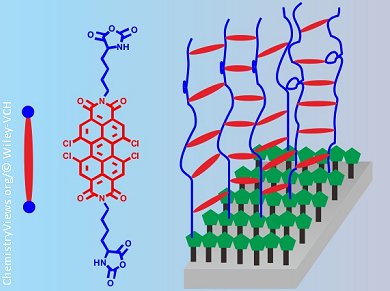Surface-grafted π-conjugated organic semiconductor layers are attractive for organic electronics and surface nanotechnologies. Researchers in China have developed a simple and universal method to construct compact polymeric n-type semiconductor films from corresponding lysine N-carboxylic anhydride (NCA) monomers by surface-initiated ring-opening polymerization (SI-ROP).
Zhibo Li and co-workers, Institute of Chemistry, Chinese Academy of Sciences, Beijing, China, synthesized asymmetric and symmetric perylene bisimide (PBI) functionalized L-lysine NCAs (PBI–NCAs) for the first time. Preparation started from PBI derivatives functionalized with one or two lysine residues, which were treated with triphosgene to yield the PBI–NCA monomers. These two unique PBI-NCA monomers were used in SI-ROP on the surface of silicon wafers functionalized with primary amine. The resulting n-type semiconductor films were flat and compact, and their thicknesses could be easily tuned by polymerization conditions.
This study holds promise for large-area surface modifications for electronic devices directly from organic semiconductor-functionalized monomers.
- Surface-Grafted Semiconductor Layer Prepared by Surface Initiated Ring-Opening Polymerization of l-Lysine NCA Derivative,
Wenxin Fu, Kai Sun, Zhibo Li,
Chem. Asian J. 2014.
DOI: 10.1002/asia.201402100




